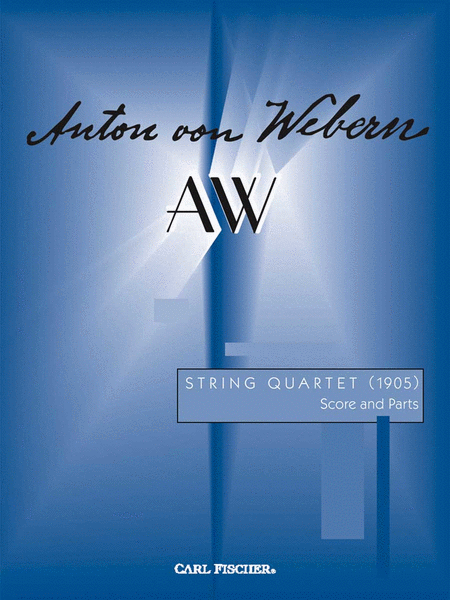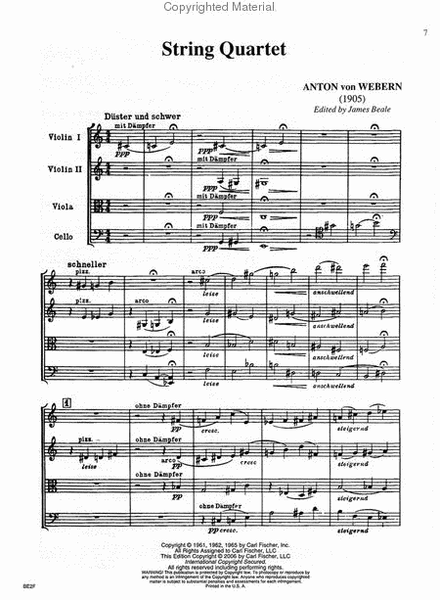String Quartet (1905)
Score and Parts
-
Ships in 1 to 2 weeks
Details
Description
SKU: CF.BE2
Score and Parts. Composed by Anton Webern. Edited by James Beale. FS-SWS. AW, Anton von Webern. Classical. Set of Score and Parts. With Standard notation. Composed 1905. 7+8+7+7 pages. Duration 12 minutes, 15 seconds. Carl Fischer Music #BE2. Published by Carl Fischer Music (CF.BE2).ISBN 9780825860782. UPC: 798408060787. 9 X 12 inches. Key: A minor. German.
CARL FISCHER has published the following works by Webern, all of which are taken from his autograph manuscripts in theMoldenhauer Archives. None of these works were published during his lifetime, and some in fact were only discovered inOctober 1965, twenty years after his death. These works, therefore, represent a valuable addition to the comparatively smallnumber of works available when he died.
The manuscript of Anton von Webern’s String Quartet (1905) came to light only in 1961, when itwas found among a number of compositions from Webern’s earlier creative period, all of whichhad previously remained unknown.The year 1905 was a productive one for Webern. While receiving academic training at theUniversity of Vienna, he had sought the private tutelage of Arnold Schönberg, the mentor andfriend with whom he was soon to forge ahead on the still uncharted course towards a new idiomof musical expression. At the end of their first year of association, immediately after composingLangsamer Satz for string quartet* in June of 1905, Webern set to work on a more expansive andambitious essay in the same genre. A formal plan, dated July 13, prefaces the earliest sketchesto the String Quartet. It reveals that the composer derived his inspiration from a painting, thetriptych Werden—Sein—Vergehn by Giovanni Segantini (1858–1899), an artist renowned forhis portrayal of grandiose mountain scenery. Feeling a strong affinity with Segantini’s world,Webern had written into his diary the preceding autumn, following a performance of Beethoven’s“Eroica” Symphony by the Vienna Philharmonic under Felix Mottl:I long for an artist in music such as Segantini was in painting. His music would haveto be a music that a man writes in solitude, away from all turmoil of the world, incontemplation of the glaciers, of eternal ice and snow, of the somber mountain giants. Itwould have to be like Segantini’s pictures. The onslaught of the Alpine storm, the mightyforce of the mountains, the radiance of the summer sun on flower-covered meadows—all these would have to be in the music, born immediately out of the Alpine solitude.That man would then be the Beethoven of our day. An ‘Eroica’ would inevitably appearagain, one that is younger by 100 years.The String Quartet was written at the Preglhof, the Webern family’s country estate in Carinthia.On the finished score appears the date August 25, 1905. Segantini’s triptych, the composer’soriginal inspiration, remained the formal model; there are three clearly discernible sectionswithin the one-movement structure. To express the depth of his involvement with the work,Webern gave it the literary motto appearing on the following page, a quotation from the Germanreligious mystic Jacobus Boehme.The String Quartet (1905) had its world premiere on May 26, 1962, during the First InternationalWebern Festival in Seattle, Washington, when it was played by the University of WashingtonString Quartet. The first performance in Europe, by the La Salle Quartet, took place on August3, 1965, during the Second International Webern Festival at Salzburg/Mittersill.


 Share
Share